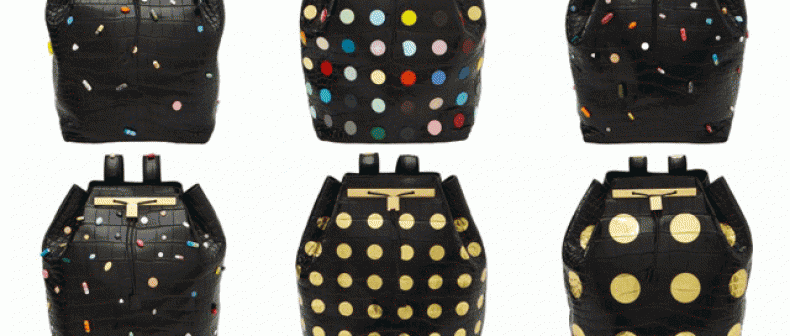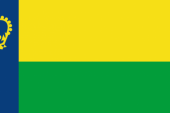
At one time, polka dots were reserved for children’s clothing and Mary-Kate and Ashley Olsen were best known for cavorting around San Francisco parks with older man John Stamos. Nowadays, the Olsen sisters are known for cavorting around New York parties with older man Ben Kingsley, while polka dots have ditched the nursery and, via the art gallery, returned to the runway. Like the former child stars, maybe polka dots have finally grown up.
First it was Marc Jacobs who recognized the stylishness of spots by collaborating with dot-obsessed artist Yayoi Kusama for Louis Vuitton. This week came the news that the Olsen twins had worked with ‘Just One Eye’ and Damien Hirst, the artist everyone loves to hate, to create a collection of limited edition black crocodile backpacks covered with polka dots, just like Hirst’s controversial, assistant-produced paintings. On some of the packs the dots are gold, while the multi-coloured ones look like circles of powdered makeup dislodged from their compacts. The bags retail for $55,000. As one blogger put it, “It must be fun to pretend we’re not in a financial crisis.”
Another version of the backpack comes decorated with artificial pills (including a small, blue Viagra) and unsurprisingly the ‘pill bag’ has been swallowing up attention. As Michael K. wrote on Dlisted: “In all seriousness, if you really want this, let’s just go to Wilson’s Leather together, buy the cheapest backpack there and then Super Glue some pills on it…But why would you want pills on your backpack anyway? Do you know how many Lohans will be chasing after you, trying to nom nom nom on your bag?” But the other, less gimmicky bag suggests an interesting question: are polka dots, having finally shaken off their childish past, ready for their fashion close up?
Polka dots weren’t always associated with the cheerfulness of kids toys and ‘itsy bitsy, teeny weeny’ bikinis. According to Jude Stewart for Slate magazine, in Medieval Europe spotted patterns had sinister connotations. “It wasn’t easy to space the dots evenly without the help of machines,” he writes, “and irregularly spaced spots connoted more than anything the first visual manifestation of disease, particularly leprosy, syphilis, smallpox, bubonic plague, and measles.”
Although dots were present in the traditional patterns of cultures around the world, they didn’t become fashionable in the West until aristocrats in the 17th century began covering their blemishes with small black ‘beauty marks’. As a pattern for clothing, polka dots greatly benefited from the rise of machine-manufactured textiles in the early 19th century. The design of repeating small dots went by various names until a certain dance craze spread through Europe with the speed and stubbornness of the plague centuries before.
Named either after the Czech word for ‘step’ or the term for Polish women, the Polka, a variation of quick-moving folk dancing, spread from Bohemia westward across the continent, reaching London by the 1840’s where it traveled to America and, along with Queen Victoria’s entourage, to India. The Polka became such an inescapable craze (the ‘Gangnam Style’ of its day) that marketers began attaching the name to anything–polka puddings, polka curtains, polka hats, gloves, and shoes. Godey’s Lady Book attached the word to the popular dotted pattern, and while the dance fad eventually waned, the name stuck.
Yayoi Kusama at the Louis Vuitton store in New YorkAs a simple, unobtrusive pattern, polka dots were common for bed sheets, curtains, and nightgowns. But as Stewart writes, “the tiniest of tweaks–packing the dots more tightly together, say, or allowing them to jostle and overlap–could produce a woozy sense of acceleration, even an exhilarating disorientation.” Perhaps it was their rhythmic quality that attracted Kusama to polka dots. “Our earth is only one polka dot among millions of others,” she has said.
I don’t usually wear patterns that aren’t stripes, checks, or plaids. This might be because I think variations of straight lines aremasculine, while dots, paisley, and imagery are feminine. (I don’t know why this would bother me–I wear pink all the time.) But I recently purchased a white shirt with tiny black polka dots. Kusama’s right. As you stare at a dot you can picture zooming in and discovering a whole little world.
I realized that it wasn’t simply history that tied polka dots to infantilism. The small, perfectly round spots are cute in a way plaid or zig zags aren’t. And because they are always distanced from each other, each individual polka dot looks lonely, in need of a hug. As the Olsens might remind you, cuteness has a dark side.
____
Max Mosher writes about style for Toronto Standard. You can follow him on Twitter at @max_mosher_.
For more, follow us on Twitter @TorontoStandard or subscribe to our newsletter.














